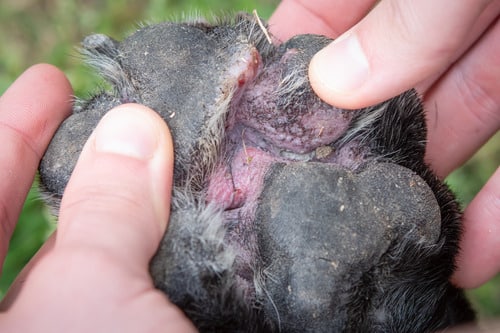Yeast infections in dogs can be a source of significant discomfort, particularly when they affect sensitive areas like the paw pads. At Arrowhead Animal Hospital in Westminster, Colorado, we understand how troubling these infections can be for your beloved pet. This blog will cover the symptoms and treatment options for dog yeast infections in the paw pads, providing you with essential information to recognize and address this issue effectively. If you suspect your dog has a yeast infection in their paw, call us at (303) 469-1616.
Symptoms of Dog Yeast Infection Paw Pads
Dog yeast infection paw symptoms can be distressing for both the dog and the owner. Recognizing these symptoms early can help in seeking timely veterinary care, which is crucial for your dog’s comfort and health.
Persistent Itching and Licking
One of the most common signs of a dog yeast infection paw is persistent itching and licking. Dogs often try to relieve the irritation caused by the yeast infection by licking or chewing their paws excessively. If you notice your dog focusing on their paws more than usual, it may be time to schedule a veterinary check-up.
Redness and Swelling
Redness and swelling are other indicators of a yeast infection. Infected paw pads often appear inflamed, and the skin between the toes may be particularly red and swollen. This inflammation is a response to the yeast infection and can be very uncomfortable for your pet.
Odor and Discharge
A distinctive symptom of a yeast infection is an unpleasant odor. The infection may also produce a discharge, which can range from a clear to a yellowish color. This discharge, combined with the smell, is a telltale sign that your dog might be dealing with a yeast infection.
Changes in Paw Pad Texture
Yeast infections can cause the texture of your dog’s paw pads to change. They may become rougher, thicker, or even flaky. These changes are due to the infection affecting the skin’s natural state, making it essential to seek veterinary advice if you notice any unusual changes.
Pain and Sensitivity
Dogs with a yeast infection in their paws may show signs of pain and sensitivity. They might limp or avoid putting weight on the affected paw. If your dog seems reluctant to walk or appears to be in pain, a yeast infection could be the culprit.
Causes of Dog Yeast Infection Paw Pads
Understanding the causes of dog yeast infection paw pads can help in preventing future occurrences. Several factors can contribute to the development of these infections.
Allergies
Allergies are a significant cause of yeast infections in dogs. Food allergies, environmental allergens, or contact allergies can disrupt the skin’s natural balance, leading to yeast overgrowth. Identifying and managing your dog’s allergies can help prevent these infections.
Moisture and Humidity
Moist environments are ideal for yeast growth. Dogs that frequently get their paws wet or live in humid climates are more prone to yeast infections. Ensuring your dog’s paws are dry and clean can help minimize the risk of infection.
Immune System Imbalances
A weakened immune system can make dogs more susceptible to infections, including yeast infections. Conditions that compromise the immune system, such as chronic illnesses or certain medications, can increase the likelihood of your dog developing a yeast infection.
Underlying Medical Conditions
Certain underlying medical conditions, such as hypothyroidism or Cushing’s disease, can predispose dogs to yeast infections. These conditions can affect the skin’s health and create an environment conducive to yeast overgrowth.
Poor Hygiene
Poor hygiene practices can also lead to yeast infections. Regular grooming and cleaning of your dog’s paws can help prevent infections by keeping the skin healthy and free from excessive moisture and debris.
Diagnosing Dog Yeast Infection Paw Pads
Accurate diagnosis of a dog yeast infection paw is essential for effective treatment. Veterinary professionals use several methods to diagnose these infections.
Physical Examination
A thorough physical examination is the first step in diagnosing a yeast infection. Your veterinarian will inspect your dog’s paws for signs of redness, swelling, discharge, and odor. They may also look for any other symptoms that could indicate an infection.
Skin Scraping and Cytology
Skin scraping and cytology are common diagnostic tests for yeast infections. A small sample of skin cells from the affected area is collected and examined under a microscope. This test helps identify the presence of yeast cells and determine the severity of the infection.
Allergy Testing
Since allergies are a common cause of yeast infections, your veterinarian might recommend allergy testing. Identifying specific allergens can help in creating a management plan to prevent future infections.
Blood Tests
Blood tests can help identify underlying medical conditions that may contribute to yeast infections. Conditions like hypothyroidism or immune system imbalances can be detected through comprehensive blood work.
Treatment Options for Dog Yeast Infection Paw Pads
Treating a dog yeast infection paw involves a combination of topical and systemic therapies. The goal is to eliminate the infection and alleviate your dog’s discomfort.
Topical Treatments
Topical treatments, such as antifungal creams and ointments, are commonly used to treat yeast infections. These products are applied directly to the affected area to target the yeast and reduce inflammation. Regular application as prescribed by your veterinarian is essential for effective treatment.
Medicated Shampoos
Medicated shampoos can also be beneficial in treating yeast infections. These shampoos contain antifungal ingredients that help eliminate yeast and soothe irritated skin. Bathing your dog with a medicated shampoo can help manage the infection and prevent its spread.
Oral Medications
In more severe cases, oral medications may be necessary. Antifungal drugs, prescribed by your veterinarian, can help treat the infection from within. It’s important to follow your veterinarian’s instructions carefully when administering these medications.
Addressing Underlying Causes
Addressing any underlying causes, such as allergies or medical conditions, is crucial for preventing recurrent yeast infections. Your veterinarian may recommend dietary changes, allergy management plans, or treatments for underlying health issues to keep your dog healthy and infection-free.
Regular Hygiene Practices
Maintaining good hygiene practices is key to preventing yeast infections. Regularly cleaning and drying your dog’s paws, especially after exposure to moisture, can help prevent yeast overgrowth. Routine grooming and veterinary check-ups are also important for maintaining your dog’s overall health.
Preventing Future Yeast Infections
Preventing future yeast infections requires a proactive approach. By taking certain measures, you can reduce the risk of your dog developing these infections.
- Diet and Nutrition: A balanced diet is essential for your dog’s overall health and can help prevent yeast infections. Ensuring your dog receives the necessary nutrients supports their immune system and skin health. Consult your veterinarian for dietary recommendations tailored to your dog’s needs.
- Regular Veterinary Check-Ups: Regular veterinary check-ups are crucial for early detection and management of potential health issues. Routine examinations allow your veterinarian to monitor your dog’s health and address any concerns before they become serious problems.
- Proper Grooming: Proper grooming is essential for maintaining healthy skin and preventing infections. Regularly trimming your dog’s nails, cleaning their ears, and grooming their coat can help prevent the conditions that lead to yeast infections.
- Environmental Control: Controlling your dog’s environment can also help prevent yeast infections. Avoiding exposure to damp or humid conditions, and ensuring your dog has a clean, dry living space, can reduce the risk of yeast overgrowth.
- Allergy Management: Effectively managing your dog’s allergies can prevent yeast infections. Work with your veterinarian to identify and manage allergens that may trigger skin issues. Allergy management may include dietary changes, medications, or environmental modifications.
Contact Us for Help with Dog Yeast Infections
Dog yeast infections, particularly those affecting the paw pads, can be uncomfortable and concerning for pet owners. By recognizing the symptoms early and seeking appropriate veterinary care, you can help your dog recover quickly and comfortably. If you suspect your dog has a yeast infection in their paw pads, call Arrowhead Animal Hospital at (303) 469-1616. Our team is here to provide the care and support your pet needs.





